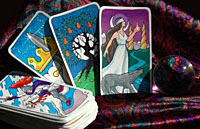Tarot Cards

This series of articles discusses the physical nature of the tarot cards, what they mean and how they are used.
Tarot Cards contain the same suits as Spanish and Italian playing cards: Batons, Coins, Cups, and Swords. The first suit is Batons they are said to represent peasants or fire and take the shape of the club. Coins represent merchants or earth and take the shape of diamonds. Cups represent chalices, churchmen and water and take the shape of hearts. Swords represent aristocracy, lords, knights and air taking the shape of the spade. There are fourteen cards per suit and four court cards (king, Queen, Knight and Page). However what defines tarot cards is the twenty- two extra cards known as the trumps or major arcana. The pack is divided in to two sets with the tenth trump the wheel of fortune representing the turning point between the first set which is the development of the world outside and the second set representing the world within oneself.
Many including tarot author Eden Gray (20th Century) believe the major arcana represent the fools journey through life. However some people believe the cards begin with the fool and result in the world. Others argue that the cards begin with the world and end with the fool. Both sides expressing life with very different outcomes on the one hand people are born fools and gain the world on the other they are born with the world and end up fools.
Tarot cards are used to access the unconscious. The cards are said to represent what cannot be expressed through words. Many occults believe that the cards communicate secret information to be interpreted in the future. The cards have been used in psychology with patients picking a card that they identify with. This was common practice for Sigmund Freud but is no longer a popular method. Tarot is still used today as a means of education for students learning about the renaissance era.
